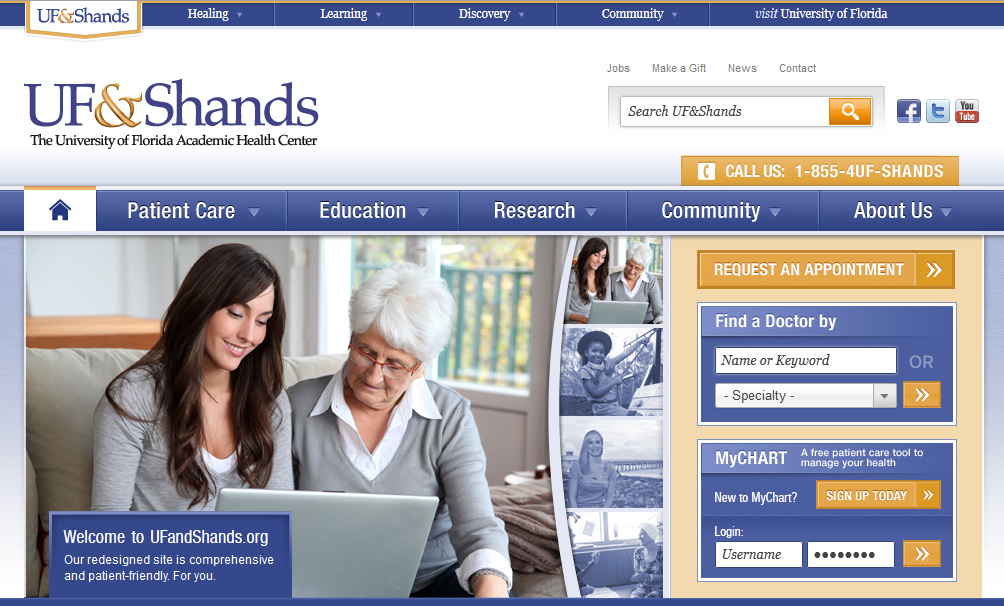UFandShands.org

When you want to find out something about anything, where do you go? Most of us would answer: “The Web, of course.” Patients, applicants to our colleges and residency programs, researchers and others with an interest in UF&Shands are no different. Whether they are trying to get information about college admissions procedures, an investigator, a fellowship, specific medical conditions, doctors, a hospital service…whatever, they typically search for this information directly from the Internet through our web pages, or indirectly through social media.
And what have they found to date? To be charitable, let’s just say their experience has been variable depending on what they’re looking for. But things are changing for the better. Earlier this week, we announced the launch of our new website, UFandShands.org, which will dramatically improve the quality and consistency of the experience of visitors to our website.
When you click on UFandShands.org ("&" is not legal for a URL domain name), you will find a brand new look and feel for the home page, which brings together the Health Science Center and Shands home pages into one integrated site. (See screen shot below.) Modern technologies and an updated interface have brought greater functionality and navigability to the new site, and there is consistency in the user experience as one moves from page to page.

The new format is now being carried through to the other colleges, departments and centers that make up UF&Shands. Not all units have yet been reformatted, but thus far about 40,000 pages have been moved over to the new site with the new format. At the same time, we are automatically populating certain elements where possible (such as news items) to remain current, while reducing the number of website pages where content has to be updated manually, to ensure more accurate and timely information. Furthermore, by employing cutting-edge search engine optimization and a new content strategy, we will improve the amount of traffic we attract via search engines. This will provide more opportunities for our visitors to discover the information they are seeking. Our new website will also serve as a reliable source of health-related news content and subject-matter expertise for the media and other external audiences.
In the spirit of “the patient comes first,” we have started out by concentrating most of our attention in the new site on our patients. UFandShands.org is designed to help current and prospective patients access the information and services they need for their health care, and also to connect them to opportunities for participation in UF research studies. We have also begun to reformat and update the research and education pages, so as to orient and connect current and prospective students, trainees, faculty, collaborators and others to the comprehensive educational and scientific resources of UF&Shands as the University of Florida Academic Health Center. As all of the academic colleges, departments and centers move over to the new format, faculty and designated administrators will be able to update the site easily and conveniently, conveying new developments in their areas in a vibrant and timely manner.
Let’s look at some of the key innovations in technology, content, look and feel, and functionality:
Technology: Our evaluation process for our underlying content management system assessed solutions across the entire spectrum of possibilities. We brought in third-party vendors to provide contemporary external perspectives and also examined open-source, community-supported solutions that can provide state-of-the-art features at minimal cost. In the end, we felt confident in our ability to leverage free, open-source solutions, but to develop them in-house to meet our unique needs. We also took steps to implement new IT infrastructure to support our new website platform and to ensure responsiveness while being dependable and available.
Content: The web content theory that guided the development of UFandShands.org can be summed up in two words: making connections. It’s easy to take this concept for granted, but it is often forgotten by large organizations that are unable to link their basic website components in a functional manner. What’s left is a disjointed behemoth that can’t be easily navigated. So, we took a step back and focused on connectivity and navigability from first principles. Under the leadership of Carlos Morales, who heads the web services team, and based on the principles of the semantic web using modern technologies, we developed a common framework that can reuse content from different sources, while making it readily available for our visitors. If someone is researching information about a specific medical condition, for example, we try to provide this information in an easily retrievable manner, but also illuminate their path in other directions: the user will now be able to gain information on where they can receive care at UF&Shands, on faculty members with clinical expertise in this area, on faculty research, and whether we’re conducting any related clinical trials. From viewing a single health topic, users now gain information on the following categories:
- Providers
- Locations
- Research studies
- Our approach to care
- Videos
- News releases
- Patient testimonials
- Departments/Specialties
…and this is just version 1.0!
also worth noting that throughout the website you will see details in the smallest of places. Subtle gradients and drop shadows; refined edges and coordinated colors. The website was designed visually to represent quality, trust, and comfort.
Functionality: If the website isn’t intuitive and easy-to-use, then none of the above matters. Throughout every major step in the process, the web development team asked: “Is this easy to use — does it feel natural and intuitive?” They considered what the user’s experience would be at each turn and strived to design elements that did not result in an individual feeling confused, frustrated or required to read instructions.
On the morning of the launch, Monday, June 4, there was a flurry of emails, announcements, tweets and other communications announcing the formal release of the website. By around 9 a.m., thousands of visitors clamored to get a look at the new site. Later that morning, at a given moment in time, 420+ real-time visitors were browsing the website (compared with an average of 40), viewing more than 200 pages/minute.
The most impressive metric, however, comes from the “request an appointment” form. On the old website, this form was submitted (on average) seven times per day. On launch day, however, we saw 23 requests for appointments. Equally impressive in terms of the power of the new website, it was found that over 50% of appointment requests came from our new provider and health topic pages (both of which feature large ‘request an appointment’ buttons, and which pass onto the request form information that helps to better triage the appointment request). Over the next few weeks and months, Google will begin re-indexing the entire website (8,000+ pages). During this process, they will recalculate our PageRank, and over time we will learn more about the effectiveness of the new website on the amount of traffic we attract from search engines.
I would like to thank our Web Executive Steering Committee and the many Web project subcommittee members who helped to direct this effort, led by Chief Information Officer Kari Cassel, Chief Communications Officer Melanie Ross and Senior Director of Strategic Communications Wanda English. And I would like to especially acknowledge our truly extraordinary website services team for their intensity of commitment to this project and their superb execution:
- Carlos Morales, Assistant Director, UF&Shands Web Services. Project lead.
- James Young, Web Designer. Responsible for expanding on and building out the site’s visual design (based on an earlier concept developed by a team of in-house designers) and much of the programming.
- Jeff Stevens, Web Content Optimizer. Our usability guru and information architect.
- Greg Turner, Senior Web Developer. Coordinated and implemented components such as the health enclyclopedia and provider directory.
- Amanda Austin, Web Content Editor and Social Media Manager. Worked closely with departments and communicators to migrate and refine thousands of pages of content.
- Sean Jeng, Web Developer. Programmed features like the autocomplete search results and coordinated with multiple IT teams to integrate research study data and establish our server infrastructure
- Diane Millican, Business Analyst. Supports and trains our content managers.
- Brad Alderman, Web Designer. Works closely with academic and research units in designing effective websites.
In the future, after completing the launch across all colleges, centers and hospitals, we will do everything we can to facilitate continual updating of web pages at the department and faculty level. Once faculty and staff learn how easy it is to post content, all of the content can remain current, vibrant and relevant. We also will continue to optimize the website for a mobile experience, ensuring that users will be able to reach all of the content that they can on the desktop version, but in a design that is friendly for smaller screens.
So check out UFandShands.org, and let us know what you think. We have embarked on a journey of continued website improvement that will never end — all suggestions are welcome.
Forward Together,
David S. Guzick, M.D., Ph.D. Senior Vice President, Health Affairs President, UF&Shands Health System
About the author
